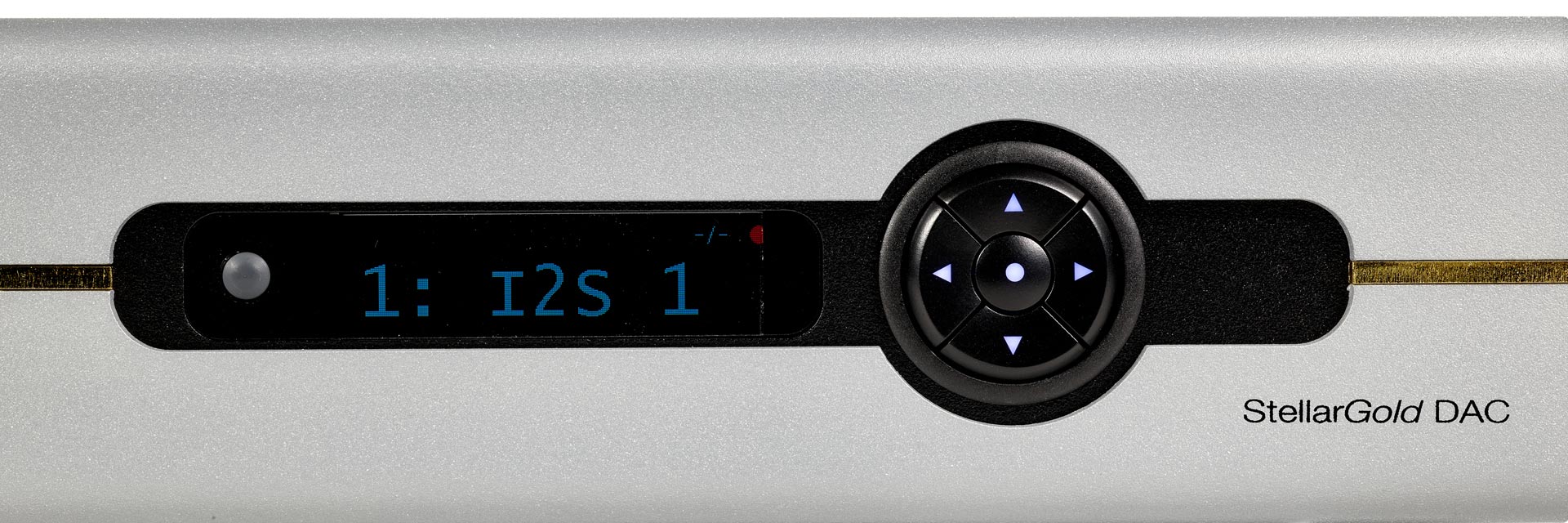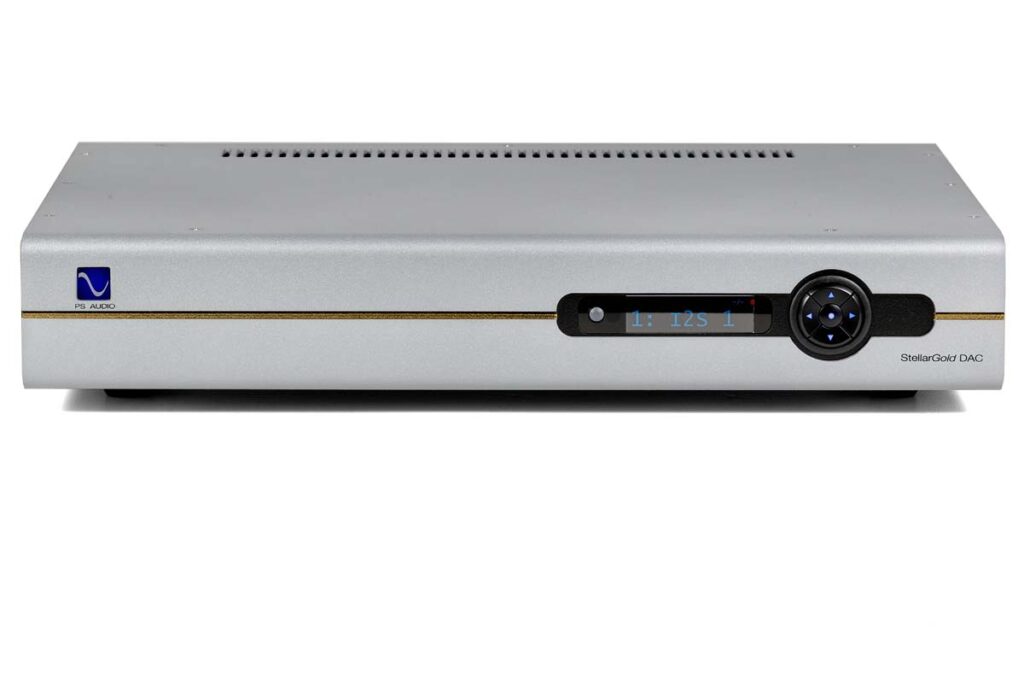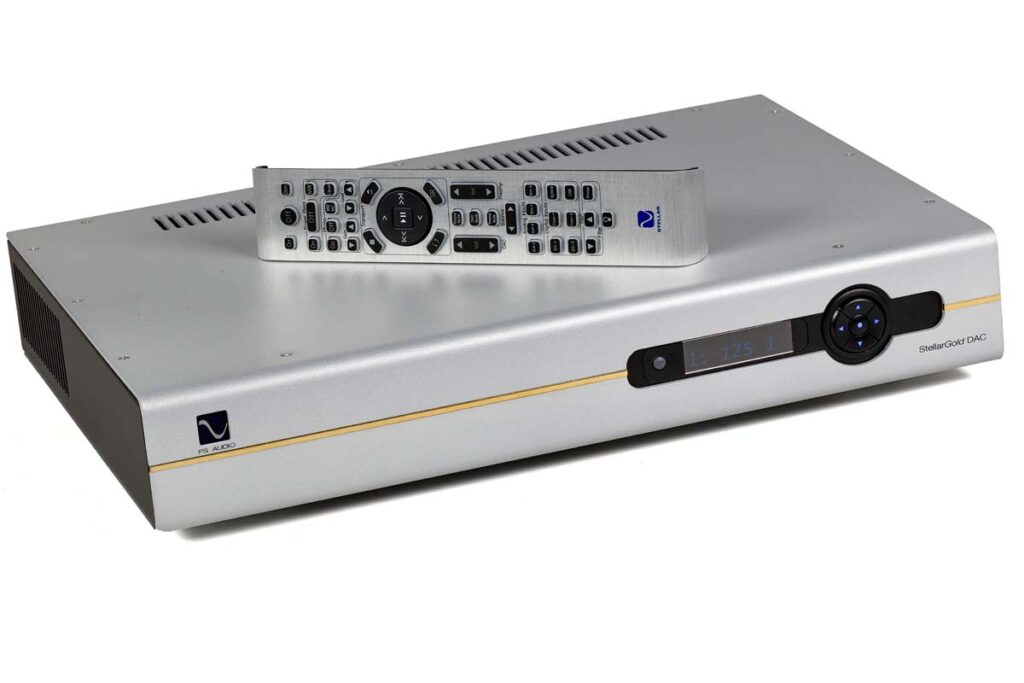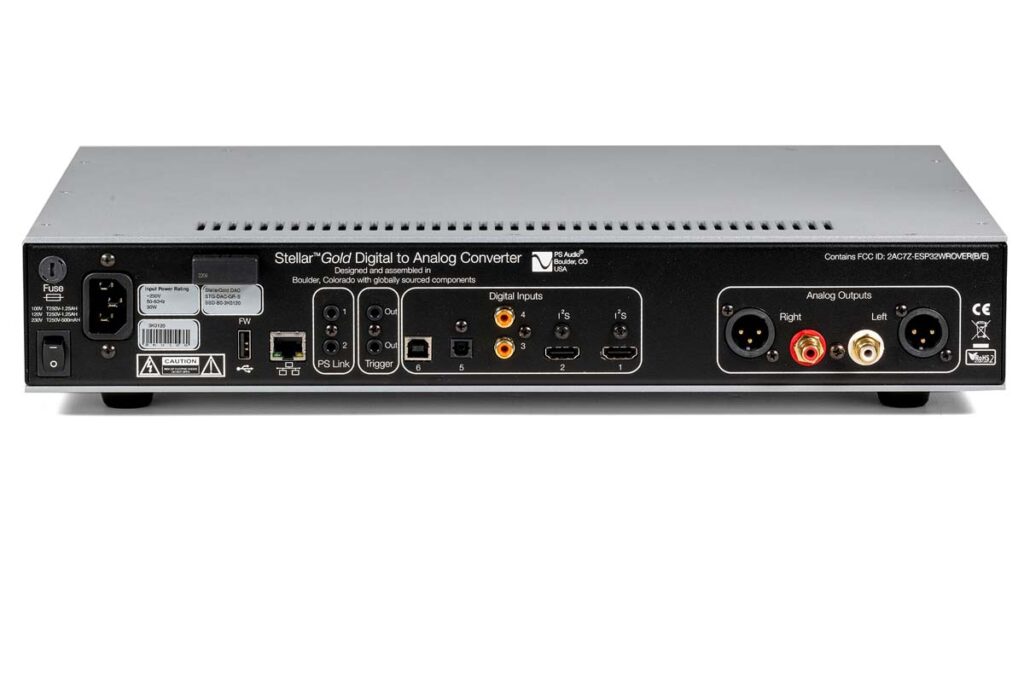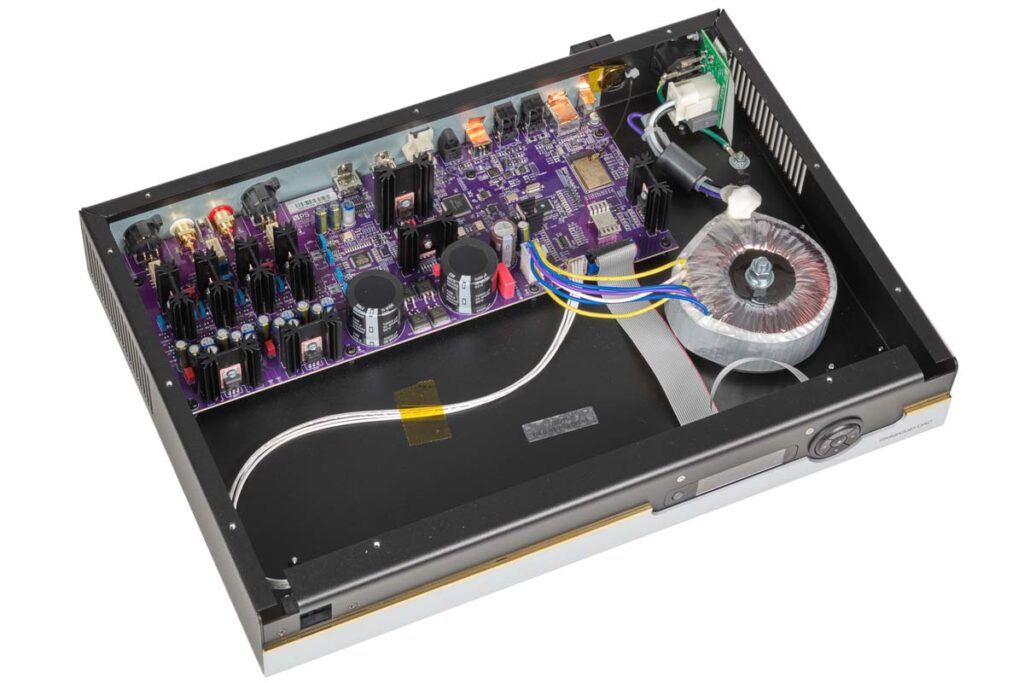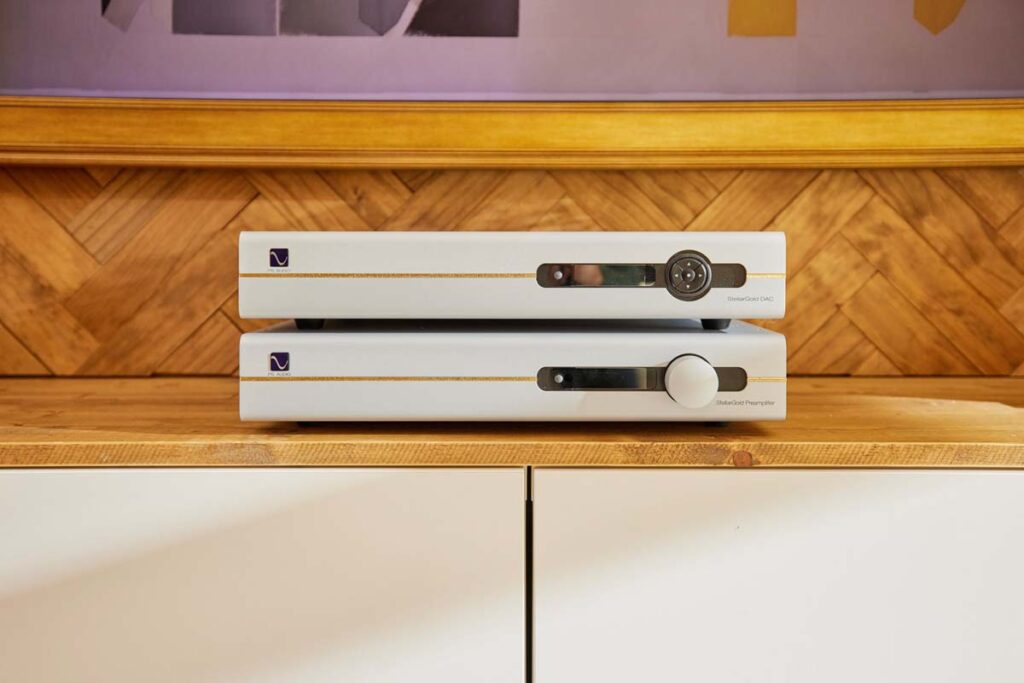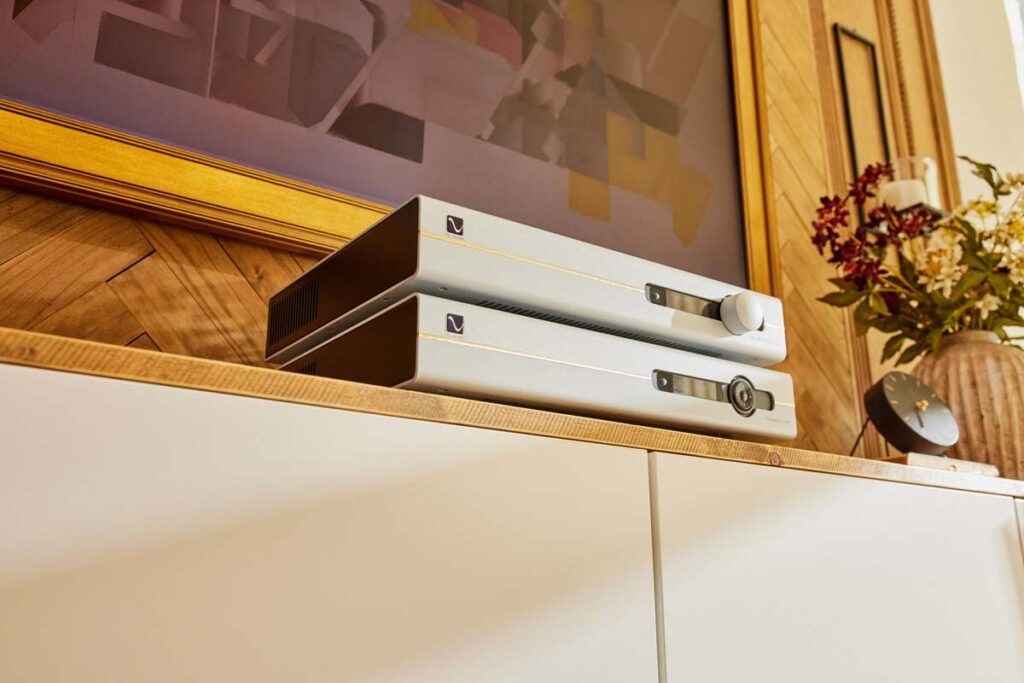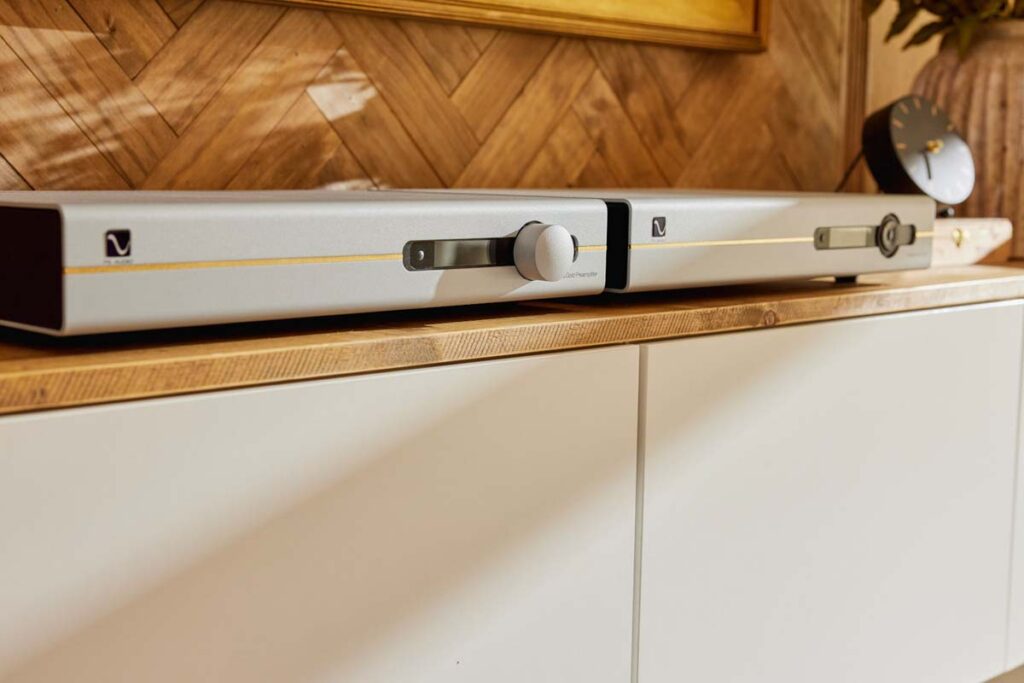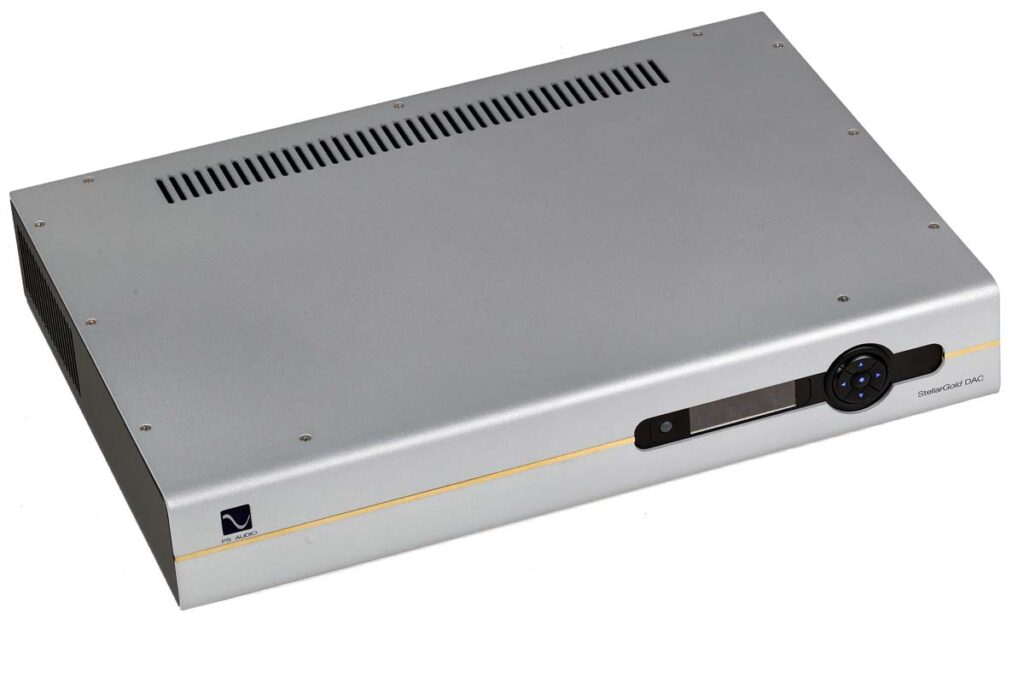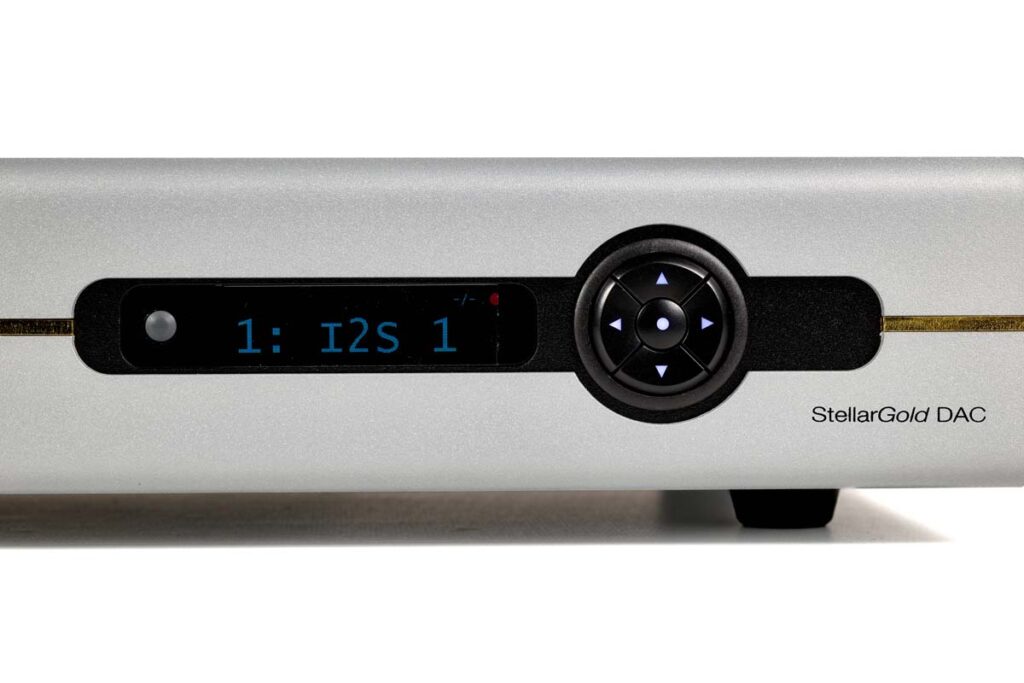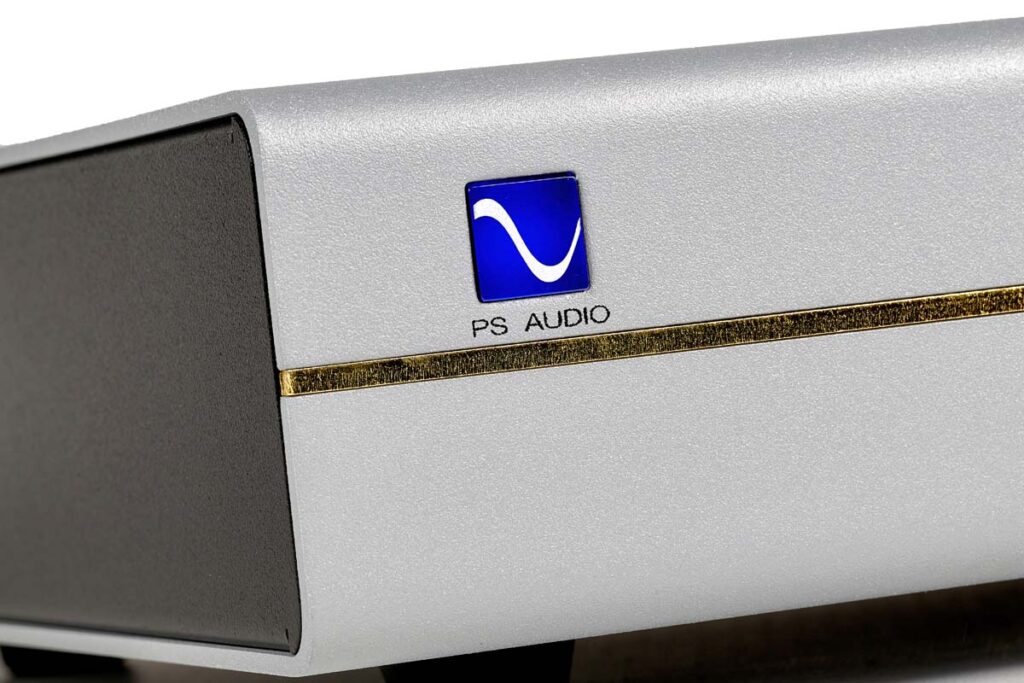How’s that for thorough: four parallel D/A converter chips per channel plus a discrete Class A output stage. The American manufacturer PS Audio has lifted the external design of the new StellarGold series from the “standard” Stellar series, but has crammed more of everything into the housing. Only the golden insert running the width of the front panel and the name badge indicate that we’re looking at a new line of devices positioned in the middle between the PerfectWave and Stellar series.
The power supply makes up the majority of the circuitry of the PS Audio StellarGold DAC. The voltage supplied by the toroidal transformer behind the front panel is processed separately for the individual audio circuits. It’s no secret that PS Audio has made a name for itself when it comes to power supplies. The circuit board directly at the inputs and outputs at the rear of the sturdy housing accommodates a total of eight DAC chips from ESS. Right next to it is the Class A output stage developed by Darren Myers (Myers has left PS Audio for Parasound in mid-2023). And Myers is not only a developer, but also a passionate music listener, an audiophile in the best sense of the word.
Now, the operation of a D/A converter is generally clear and easy to understand and, with PS Audio, can be carried out both via the supplied remote control and on the device itself. As a rule, this will be the selection of the input channel in your system. This and other functions can be called up without any problems. Only the high-gloss plastic buttons on the control surface of the device don’t feel quite up to the price tag in my humble opinion. No big deal; let’s see now how it does in terms of sonic performance.
The Vestbo Trio recorded the tracks on their new album Out Of Place in an old theater. Michael Vestbo’s guitar is reminiscent of a mixture of Bill Frisell and (sometimes) Mark Knopfler. The big-sounding drums impress with their sonic opulence, which is comprehensible in every detail despite the spacious acoustics of the theater. The volume of the bass drum on “497” is overwhelming and fits into the warm overall sound reflected by the wooden stage floor. Incidentally, the finishing touches in the mastering studio come courtesy of Bob Katz. The StellarGold DAC delivers a fine, detailed and dynamic representation of this musical experience. What stands out is the meticulousness and sovereignty across all frequency ranges. There is substance at the bottom and resolution without harshness at the top. The spatial dimension is realistic and plausible in both width and depth and without the infamous “hi-fi cloud”. Admittedly, the recording is absolute Champions League in terms of sound quality, and that’s exactly what I can hear here. As a counter-check, I use an old recording by the Scottish band Runrig, which has always moved me emotionally, but is rather average acoustically. “Harvest Moon”, for example, sounds typical of the time (1990), with shimmering acoustic guitars that were only recorded via the pickups and bright-sounding keyboards.
The PS Audio converter doesn’t conceal this period coloration, but helps me enjoy the music with its low-frequency competence and uncolored resolution in the mids and highs. Clearly, it doesn’t homogenize anything, but the potential of the recording becomes clear.
The total of six digital inputs accept material up to DSD256 and 24 bit/768 kilohertz. The highest resolution for PCM and DSD signals is possible via the two I2S inputs using a HDMI connection, provided you have a suitable player such as the PS Audio PerfectWave SACD Transport. There are also the usual suspects such as the USB input (PCM up to 384 kHz and up to DSD128), two coaxial and one optical S/PDIF input (PCM). DSD is actually converted natively via I2S and USB rather than first being converted into a PCM signal. Everything a digital control center needs is on board. On the output side, the converted audio signal can be tapped via one pair of balanced and one pair of unbalanced connections. The StellarGold DAC can also be used as a digital preamplifier, as the output can either be used as a fixed output into a preamplifier or as a variable output into a power amplifier. The ES9038Pro DAC chip from ESS Technology belongs to the manufacturer’s top series. Interestingly, this component itself is already an eight-channel converter. This means that the manufacturer has already achieved a signal-to-noise ratio on the data sheet that is far from perceptible. But that was not enough for PS Audio. By using a total of eight of these chips in parallel (four per channel), it was possible to average out any non-linearities and reduce the noise even further. As a result, even the balanced output can have a signal-to-noise ratio of more than 127 decibels at 4V RMS. At the same time, the barely measurable distortion can be further reduced by connecting the chips in parallel.
The Orb have reworked and re-released their Spheres collaboration with David Gilmour in 2023. Metallic Spheres In Colour is a spherical, but also partly driving journey through synthetic soundscapes, on which Gilmour can freely live out his typical sound as an extended solo. In “Movement 1”, the PS Audio StellarGold once again delivers a confidently tidy low-frequency foundation, above which the listening room is filled with sound from around 500 hertz. This confidence is also what the developers at PS Audio were aiming for when they increased an already inaudibly good signal-to-noise ratio even further through the parallel circuit and wanted to completely eliminate any errors of individual chips through interpolation. The listening impressions so far validate this approach. Does this make the PS Audio the class leader in the league up to 5000 euros? Well, my listening experience and the available comparison DACs indicate that, yes, this is about as good as it gets at this price, but some competitors manage equally good sounding converters via S/PDIF – at the same price, mind you. Nevertheless, there are a few unique selling points that put the PS Audio above the competition for some of us. First and foremost, the ability to play music natively in the highest possible resolution via USB and the powerful I2S interface, without downsampling or playback problems if the original data rate is too high. The discrete Class A output stage designed by Darren Myers is also not a matter of course in this segment. Operational amplifier chips are often used to process the signal or the direct analog tap of the respective converter chip is passed through to the outputs.
And: PS Audio takes us listeners seriously. The supplied mains cable worked well, but should be replaced by a better mains cable in your home system! That’s what it says in the operating instructions, and that’s how I know many of my music-listening friends live it.
While I used to feed the digital music data via S/PDIF through my CD player or streamer, I now connect the computer via USB to be able to play even higher resolution music. I play Trevor Horn’s album Echoes – Ancient & Modern in 24-bit/192 kHz resolution. On a Mac, remember to select 24-bit in the settings, as only 16-bit is selected by default. This also applies to Windows, but the settings are a little trickier to find – the easiest way is via the device manager. No need for guessing work, as the display provides information about the clock rate and resolution of the input signal so that you can make adjustments if necessary. It’s also easy to read even from a distance.
Seal is given an opportunity to interpret Joe Jackson’s classic “Steppin’ Out” on this record. On this high-resolution file, the singer’s voice is vividly tangible without ever becoming dense. The arrangement, tasteful in the truest sense of the word, is traced in every detail. The musical flow seems to me to be even more authentic and engaging via the asynchronous USB input than via the already very good S/PDIF inputs. This general confidence that builds from the deep black and powerful bass foundation, the realistic imaging and the never harsh details in the treble are also retained here, which speaks for the discrete, analog output stage. There’s competition in this price segment, yes, but there are also the unique selling points mentioned. Listen for yourself!
WITH FILTER, PLEASE
The PS Audio StellarGold DAC offers the option of switching between seven different filters in the menu. Filter 1 (minimum phase, slow roll-off) is the default. Furthermore, the usual combinations of phase linearity and filter slope can be set, and finally even the “Brickwall” setting, which calls up a filter characteristic with the steepest slope possible. As is so often the case, the differences are audible, but do not change the fundamental character of the PS Audio. The fact that the inputs can also be individually named is a matter of course in this class.
Accompanying Equipment
CD player/DAC: Luxman D-N150, Audiolab 8200CDQ | Streamer: Volumio | Pre/power amplifier: PS Audio StellarGold Preamplifier, PS Audio Stellar M1200 Amp, Audiolab 8200CDQ | Integrated amplifier: Luxman SQ-N150 | Speakers: Klipsch Heresy IV | Cables: Ecosse, TaraLabs, Furutech
PS Audio StellarGold DAC
Concept: D/A converter with native DSD conversion via USB and I2S, control option for PS Audio CD transport. 8x DAC with ESS Sabre ES9038PRO, discrete Class A output stage | Special features: all functions accessible on the device, exchangeable mains fuse | Inputs: 2 x I2S, 1 x USB B, 2 x coaxial, 1 x optical | Outputs (analog): 1 x balanced XLR, 1 x single ended RCA | Finishes: Black, Silver | Dimensions (W/H/D): 43/8/31 cm | Weight: 10.2 kg | Price: around € 4800
HiFi 2 die 4
Austraße 9
73575 Leinzell
Phone +49 7175 909032
hifi2die4@gmx.de

